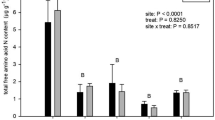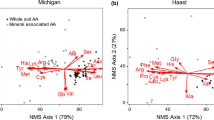Abstract
Concentrations of free amino acids were measured in soils from four major ecosystem types in arctic Alaska. Total free amino acid concentrations were several-fold higher than ammonium (the major form of inorganic nitrogen) in water extracts of soils. The dominant free amino acids in these soils were glycine, aspartic acid, glutamic acid, serine, and arginine. Concentrations of total amino acids ranged 5-fold across communities, being highest in tussock tundra and lowest in wet meadows. Incubation experiments indicate that the turnover of amino acids is rapid, which suggests high rates of gross nitrogen mineralization in these soils. The high concentrations and dynamic nature of soil free amino acids suggest that this nitrogen pool is a significant component of nitrogen cycling in these tundra ecosystems.
Similar content being viewed by others
References
Bajwa R, Abuarghub S & Read DJ (1985) The biology of mycorrhiza in the Ericaceae. X. The utilization of proteins and the production of proteolytic enzymes by the mycorrhizal endophyte and by mycorrhizal plants. New Phytologist 101: 469–486.
Bledsoe CS & Sangvanit U (1984) Organic nitrogen uptake by axenically-grown mycorrhizal coniferous seedlings. Bulletin of the Ecological Society of America 65: 219.
Chapin FS III, Shaver GR & Kedrowski RA (1986) Environmental controls over carbon, nitrogen, and phosphorus chemical fractions in Eriophorum vaginatum L. in Alaskan tussock tundra. Journal of Ecology 74: 167–195.
Chapin FS III, Fetcher N, Kielland K, Everett KR & Linkins AE (1988) Productivity and nutrient cycling of Alaskan tundra: enhancement by flowing soil water. Ecology 69: 693–702.
Chapin FS III, Moilanen L & Kielland K (1993) Preferential use of organic nitrogen for growth by a nonmycorhizal arctic sedge. Nature 631: 150–153.
Conover WJ (1980) Practical Nonparametric Statistics. 2nd edition. John Wiley & Sons, New York.
Giblin AE, Nadelhoffer KJ, Shaver GR, Laundre JA & McKerrow AJ (1991) Biochemical diversity along a riverside toposequence in arctic Alaska. Ecological Monographs 61: 415–435.
Henrichs SM & Doyle AP (1986) Decomposition of 14C-labeled organic substances in marine sediments. Limnology & Oceanography 31: 765–778.
Henrichs SM, Farrington JW & Lee C (1984) Peru upwelling region sediments near 15°S. 2. Dissolved free and total hydrolyzable amino acids. Limnology & Oceanography 29: 20–34.
Hultén E (1968) Flora of Alaska and Neighboring Territories. Stanford University Press, Stanford, California, USA.
Ivarson KC & Sowden FJ (1966) Effect of freezing on the free amino acids in soil. Canadian Journal of Soil Science 46: 115–120.
Ivarson KC & Sowden FJ (1969) Free amino acid composition of the plant root environment under field conditions. Canadian Journal of Soil Science 49: 121–127.
Jones BN, Pääbo S & Stein S (1981) Amino acid analysis and enzymatic sequence determination of peptides by an improved o-pthaldialdehyde precolumns labeling procedure. Journal of Liquid Chromatography 4: 565–586.
Jörgensen NOG & Söndergaard M (1984) Are dissolved free amino acids free? Microbial Ecology 10: 301–316.
Kielland K(1990) Processes controlling nitrogen turnover and release in arctic tundra. Dissertation. University of Alaska, Fairbanks, USA.
Kielland K (1994) Amino acid absorption by arctic plants: implications for plant nutrition and nitrogen cycling. Ecology 75: 2373–2383.
Labroue L & Carles J (1977) Le cycle de l'azote dans les sols alpins du Pic du Midi de Bigorre (Hautes-Pyrenees). Oecologia Planetarum 12: 55–77.
Ladd JN & Jackson RB (1982) Biochemistry of ammonification. In: Stevenson FJ (Ed) Nitrogen in Agricultural Soils(pp 222–228). American Society of Agronomy, Madison, Wisconsin, USA.
Lindroth P & Mopper K (1979) High performance liquid chromatographic determination of subpicomole amounts of amino acids by precolumn fluorescence derivatization with o-phaldialdehyde. Analytical Chemistry 51: 1667–1674.
Mack AR (1963) Biological activity and mineralization of nitrogen in three soils as induced by freezing and drying. Canadian Journal of Soil Science 43: 316–324.
Miettinen KJ (1959) Assimilation of amino acids in higher plants. Symposium 13, Society of Experimental Biology (pp 210–230). Academic Press, Inc., New York.
Mopper K & Zika RG (1987) Free amino acids in marine rains: Evidence for oxidation and potential role in nitrogen cycling. Nature 325: 246–248.
Nykvist N (1963) Leaching and decomposition of water-soluble organic substances from different types of leaf and needle litter. Studia Forestalia Suedica 3: 1–31.
Read DJ (1991) Mychorrizas in ecosystems. Experientia 47: 376–391.
Read DJ & Bajwa R (1985) Some nutritional aspects of the biology of ericaceous mycorrhizas. Proceedings of the Royal Society of Edinburgh, 85B: 317–332.
Sauter JJ (1981) Seasonal variation of amino acids and amides in the xylem sap of Salix. Zeitschrift fûr Pflanzenphysiologie 101: 399–411.
Shaver GR, Nadelhoffer KJ & Giblin A (1990) Biochemical diversity and element transport in a heterogenous landscape, the North Slope of Alaska. In: Baker MG & Gardner RH (Eds) Quantitative Methods in Plant Ecology (pp 105–125). Springer-Verlag, New York, New York, USA.
Shaver GR & Chapin, FS III (1991) Production: biomass relationships and element cycling in contrasting arctic vegetation types. Ecology 61: 1–31.
Soldal T & Nissen P (1978) Multiphasic uptake of amino acids by barley roots. Physiologia Planetarum 43: 181–188.
Sowden FJ, Chen Y & Schnitzer M (1977) The nitrogen distribution in soil formed under widely differing climatic conditions. Geochimica & Cosmochimica Acta 41: 1524–1526.
Stevenson FJ (Ed) (1982) Nitrogen in Agricultural Soils. American Society of Agronomy, Madison, Wisconsin, USA.
SYSTAT Inc. (1987) Evanston, Illinois, USA.
Webber PJ (1978) Spatial and temporal variation of the vegetation and its productivity, Barrow, Alaska. In: Tieszen LL (Ed) Vegetation and Production Ecology of an Alaskan Arctic Tundra (pp 37–112). Springer-Verlag, New York.
Author information
Authors and Affiliations
Rights and permissions
About this article
Cite this article
Kielland, K. Landscape patterns of free amino acids in arctic tundra soils. Biogeochemistry 31, 85–98 (1995). https://doi.org/10.1007/BF00000940
Received:
Accepted:
Issue Date:
DOI: https://doi.org/10.1007/BF00000940




